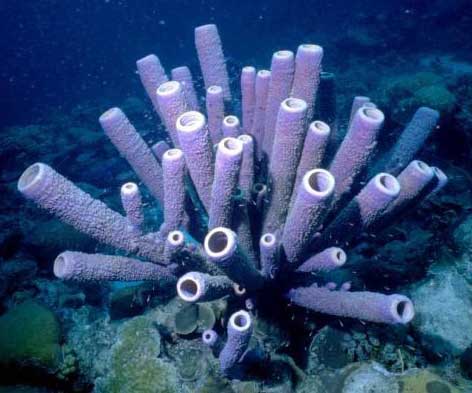

{ Characteristics }
Sponges are multicellular, heterotrophic, have no cell walls, and contain a few specialized cells. Their bodies are covered with pore cells and supported with spicules and spongin. They are all aquatic, and although they contain a few specialized cells, they have no specialized organs.
Reproduction
Sponges have two means of reproducing. They can either reproduce asexually or sexually.
Sponges can reproduce asexually by fragmentation, producing gemmules, or budding. Fragmentation occurs when their body is broken, each broken piece can produce an offspring which can grow into an adult sponge. When there are difficult environmental conditions, sponges produce gemmules - which can survive temperature extremes until the conditions become favorable to grow into a new sponge. Budding occurs when a part of a sponge breaks off and settles to the sea floor to grow into a new sponge.
Most sponges are hermaphroditic, but reproduce sexually through a process called internal fertilization. In this process, sperm are released from one sponge into a current and are taken in by another sponge. The sperm are carried to eggs inside the body wall and fertilize the eggs to form zygotes. The zygotes mature into mobile larva that settle away from their parent.
Vocabulary
choanocytes - specialized cells that use flagella to move a steady current of water through the sponge
osculum - a large hole at the top of the sponge which water leaves through
spicule - a spike-shaped structure made of chalk-like calcium carbonate or glasslike silica
archaeocytes - specialized cells that move around within the walls of the sponge, make spicules
internal fertilization - a process where eggs are fertilized inside the sponge’s body
larva - an immature stage of an organism that looks different from the adult form
gemmules - groups of archaeocytes surrounded by a tough layer of spicules
Works Cited
http://www.pznow.co.uk/marine/sponges.html
http://users.rcn.com/jkimball.ma.ultranet/BiologyPages/I/Invertebrates.html
http://sponges-porifera.wikispaces.com/file/view/sponge11.jpg/217474638/sponge11.jpg
http://biology.about.com/od/genetics/ss/Asexual-Reproduction.htm
http://www.mbgnet.net/salt/animals/1sponge.jpg
http://www.sciencedirect.com/science/article/pii/002209819190047Z
No comments:
Post a Comment